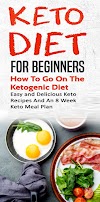What is the keto diet?
The keto diet changes the way your body converts food into energy. Eating a lot of fat and very few carbs puts you in ketosis, a metabolic state where your body burns fat instead of carbs for fuel. When your body is unable to get glucose from carbs, your liver converts fatty acids from your diet into ketones, an alternative source of energy. Burning ketones in place of glucose reduces inflammation and spurs weight loss.
The keto diet isn’t new, and it’s been around for nearly a century. It was originally developed to treat people with epilepsy. In the 1920s, researchers found that raised levels of ketones in the blood led to fewer epileptic seizures in patients. The keto diet is still used today to treat children with epilepsy who don’t respond well to anti-epileptic drugs.
HEALTH BENEFITS OF KETO
- Burns fat: You can drop a lot of weight — and quickly — on the keto diet. Ketones suppress ghrelin — your hunger hormone — and increase cholecystokinin (CCK), which makes you feel full. Reduced appetite means it’s easier to go for longer periods without eating, which encourages your body to dip into its fat stores for energy. Learn more here about the keto diet and weight loss.
- Reduces inflammation: The keto diet is anti-inflammatory, and could protect you against major degenerative diseases such as Alzheimer’s and cancer.
- Fuels and feeds your brain: Ketones provide an immediate hit of energy for your brain, and up to 70% of your brain’s energy needs when you limit carbs.Fat also feeds your brain and keeps it strong. Your brain is at least 60% fat, so it needs loads of good fats to keep it running. Essential fatty acids such as omega-3s help grow and develop the brain, while saturated fat keeps myelin — the layer of insulation around the brain — strong so your neurons can communicate with each other.
- Increases energy: Ketosis helps the brain create more mitochondria, the power generators within your cells. More energy in your cells means more energy for you to get stuff done.
- Lowers blood sugar: The keto diet may reverse and even cure diabetes. Keto stabilizes insulin levels and lowers blood sugar, to the point that many diabetics can come off their medication when switching to the diet.
KETO DIET MENU: WHAT TO EAT ON KETO
The keto diet is made up of mostly fats (75 percent of your daily calories), some protein (20 percent) and a small amount of carbs (5 percent). Choose low-carb foods such as meat, fish, eggs, vegetables, and good fats. Check out this detailed keto meal plan and browse these keto recipes to get started.
TYPES OF KETO (STANDARD, CYCLICAL, TARGETED, DIRTY)
Standard keto diet: You eat very low carb (less than 50 grams of net carbs a day), all the time. Some keto followers eat as few as 20 grams per day.
Cyclical keto diet: You eat high fat, low carb (less than 50 grams of net carbs a day) five to six days of the week. On day seven, you up your carb intake to roughly 150 grams, during what’s called a carb refeed day. Carb cycling this way helps you avoid the negative effects some people experience when they restrict carbs long term, like thyroid issues, fatigue and dry eyes.
Targeted keto diet: You follow the standard keto diet, but eat extra carbs right before (30 minutes to an hour) a high-intensity workout. The glucose is meant to boost performance, although no scientific studies have linked low blood glucose to reduced weight-lifting performance.
Dirty keto diet: Dirty keto follows the same ratio of fats, proteins, and carbs as the regular keto diet but with a twist: it doesn’t matter where those macronutrients come from. So dinner could be a bunless Big Mac with a Diet Pepsi.
HOW TO KNOW YOU’RE IN KETOSIS
You’re in ketosis when your ketone levels measure 0.8 (that’s millimoles per liter). You can test your levels using urine sticks, blood sticks, or a blood meter. You can also test for acetone levels in your breath using a breath analyzer.
However, just tracking how your body feels is a simple way to know whether you’ve hit that ketosis sweet spot. Here are signs you’re probably in ketosis:
- Reduced hunger: Ketones suppress your hunger hormones, helping you feel full for longer.
- Keto breath: People often experience a metallic taste in their mouth due to raised ketone levels.
- Weight loss: The keto diet burns fat, so if you’re losing weight, you’re likely in ketosis.
- Flu-like symptoms: When you first start out, you may experience symptoms of the keto flu, like headaches, chills and lightheadedness.
I believe that anyone can succeed with the Keto diet. By researching it and getting information now you already have shown an interest which is the first step. You have the basic motivation you need, so now you just build on that. Look into programs to see which one will fit you best and get started on this life changing mission. In no time at all, you will see the results other diets did not give you and you will feel and look great!
One good program I can direct you is: The 28-Day Keto Challenge
A very popular program that gives you a variety of easy daily recipes.
A very popular program that gives you a variety of easy daily recipes.
To Your Health!








0 Comments